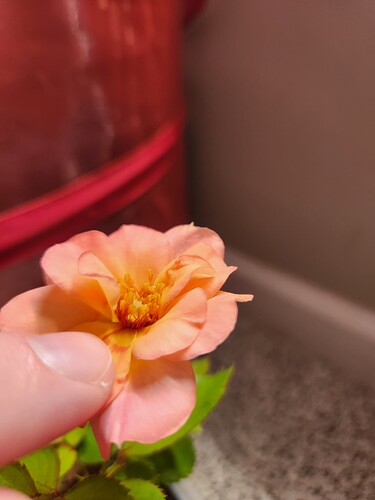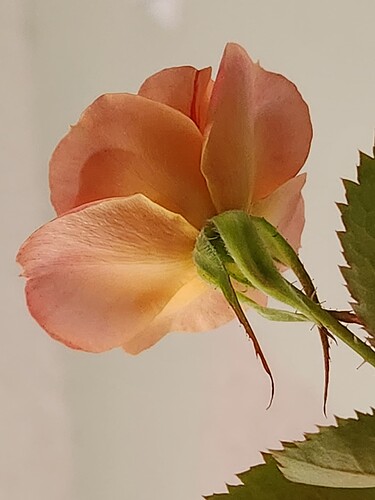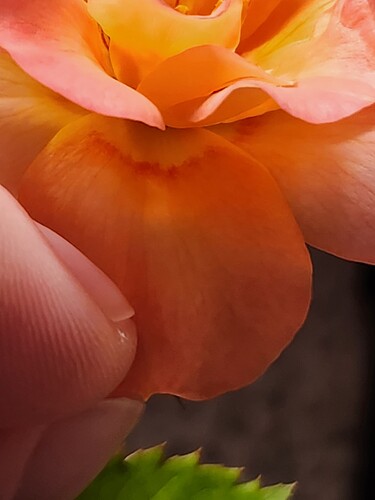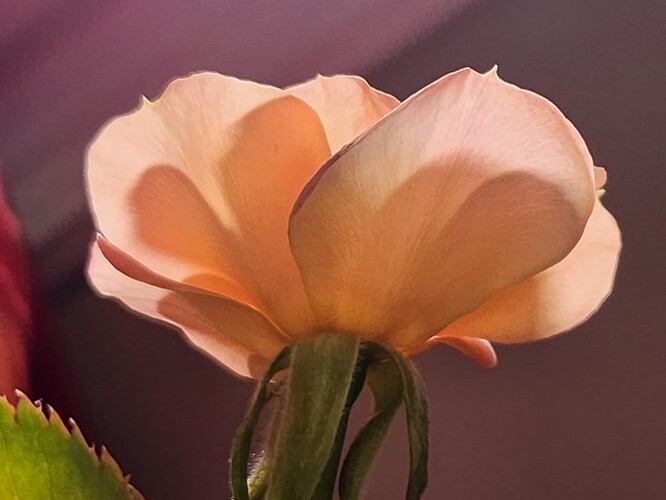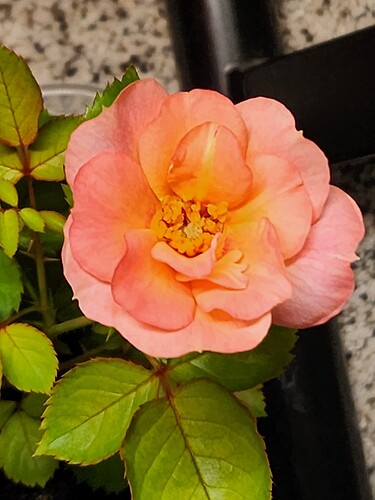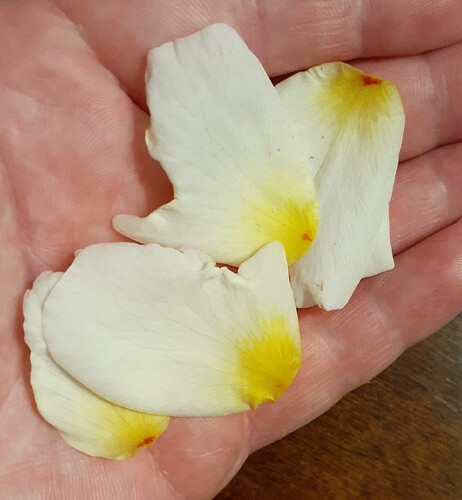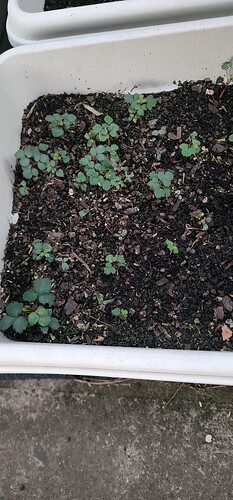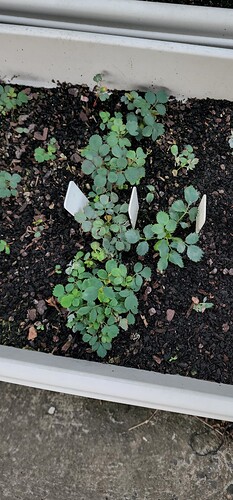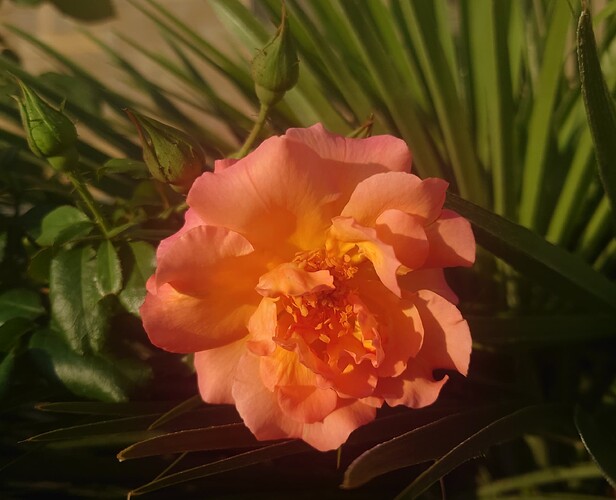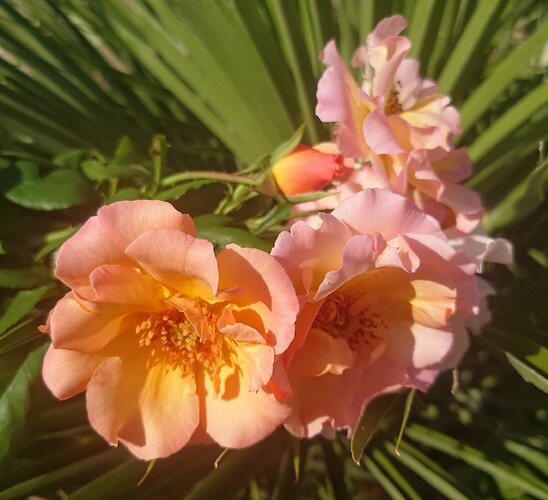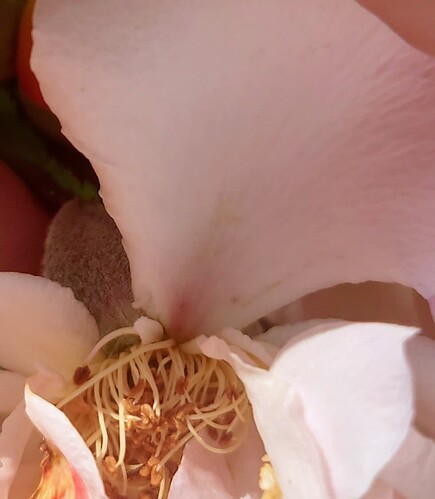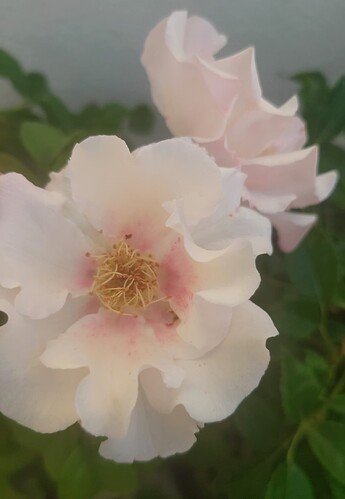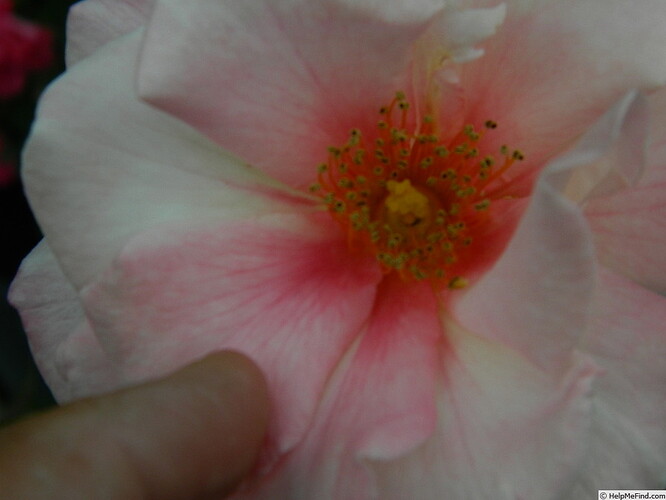Beautiful bloom!
I second what @MidAtlas said, this one seems to have a lot of qualities! What a lovely surprise!
Blackspot resistance is definitely one of my main goals, and we do get quite a lot of it here. In this specific case however I’m not sure I will be able to properly evaluate it. Eyes for you is spotless here, but I know it does get blackspot elsewhere. I assume it is susceptible to some specific strains that are not in my garden. If this susceptibility is inherited I won’t be able to notice it.
On average, I’d say that the British line of hulthemias (Warner/James/Harkness) is much healthier than the Dutch (Babylon eyes) and american ones, as far as blackspot is the main concern. The new Kordes’ See you series may be a nice point to start from. I have recently acquired See you in pink (5 stars for blackspot resistance according to Kordes and ADR) and I have an OP seedling from it growing. The seedling is very susceptible to powdery mildew, so careful mating could be needed. It could be a selfing suffering due to inbreeding issues, though
Here is a bloom from an eyeconic mango lemonade seedling. Looks like itll develop the splotch. Its pretty vigorous too. No fragrance though ![]() .
.
I really like the line variation–it’ll be interesting to see how that seedling develops with further maturity! The almost kaleidoscopic variations that Jim Sproul has gotten from his seedlings are truly astounding. I wonder if the markets are only still dipping their toes in the “blotch,” or if we’re ready to see more variation in shape and color on the open market. Some of his selections that haven’t made it to market are far more interesting in appearance, at least to me, although it’s hard to say what other marketable qualities they might have lacked.
My contribution to this line of inquiry consists of what appears to be an extremely underwhelming blotch (so far), except for two things that might make it unusual. First, the blotch only appears once the flower is fully mature and the base color of the petals has lightened from a soft orange-yellow to nearly cream (indoors under lights, as observed through the seedling’s third flower to date). Second, but maybe more interesting, is that neither parent has a blotch at any point in its floral development, nor any known or published Rosa persica ancestry–although the background of one parent is completely unpublished.
One semi-wild guess as to why this might have occurred is that the seedling has Anytime as a great-great-great maternal grandparent. Having that Halo Series progenitor as an ancestor might allow for better expression of the R. persica blotch trait, and I’ve noticed that a number of of Jim Sproul’s named introductions have Anytime in their background. The pollen parent has no published background whatsoever; it is an Austin rose. I should note that none of this seedling’s siblings have shown similar tendencies. This one is unique so far.
The cross is Yellow Submarine x Lady Emma Hamilton:
Stefan
Are you confident that Lady Emma Hamilton is actually the pollen parent, Stefan? I’d find it very interesting if you were.
Both parents have been bred around 1995. I’m not familiar with Yellow Submarine, but LEH is completely modern in appearance. In 1995, as long as I know, hulthemias were still once blooming, thorny and weedy shrubs. LEH is compact, double, nicely formed, and has a nice scent.
I guess the halo genes may have come back, or some other kind of mutation may have occurred too
I’m very confident that it is the pollen parent–I’ve had past seedlings from LEH pollen using Lemon Fizz as the seed parent that had eerily similar irregular petal shapes, fairly unique fragrance (sort of a subset of the complex and excellent LEH fragrance), and even growth patterns. This one is only (very) different from them because of this late-developing, tiny (though colorful) “blotch.” I agree that it could be a somewhat different mutation without any involvement of genes from R. persica. It would have been something to see another seedling with this trait appear; I didn’t pollinate a large number of flowers and didn’t repeat the cross this season, but might try again next year.
It might also be useful to try pollinating Yellow Submarine with a rose having a stronger blotch from R. persica. YS is a modern yellow shrub rose with good yellow color that unfortunately fades quickly, and sadly has only a slight fragrance. Its strong resistance to diseases and its (initial) color, nice growth habit and rebloom, reasonably good cold-hardiness, as well as willingness to set hips and germinate, are what most interest me. If I could find its parent Singin’ in the Rain, that might also provide the same “halo” gene or genes and maybe give more orange-colored seedlings. That might be more widely available outside the U.S., even if Yellow Submarine is not, and it is supposed to have fairly good disease resistance as well.
Stefan
Stefan! That is very interesting about lady emma hamilton! I do have that one in my garden, perhaps i will have to cross it with my eyeconic mango lemonade. LEH is one of the few roses in my yard that continues to look decent throughout the season in my yard. So my hope is for better disease resistance.
It does seem like some crosses with healthier blotched roses could be worth a try–and Lady Emma Hamilton does have one descendant listed involving it as a seed parent. I’ve only ever tried using LEH as a pollen parent so far. My plant is also far from healthy, keeping just a few spotty leaves for most of the summer, but it’s easier to mask those naked stems with other plants because it isn’t a massive plant. The flowers each spring and fall and occasionally in between have such a beautiful color and scent. It also has the dubious distinction of being the only rose I maintain that I know to have an RMV infection… it came directly from DA in Texas, so I wonder if there is any clean stock in the U.S.
Possibly of interest to someone
really over sown, basically the whole plants OP from BaaB/RK (aka Raspberry Kiss) in that area because germination is known to be less than ideal, next to it is a strip of similarly densely sown Candy Eyes (just not the whole plant).
Bright As A Button/Raspberry Kiss OP
vs
Candy Eyes OP
Candy Eyes seems to be the easiest germinator of Warners (although I don’t have Harmonize and there’s a few of his that haven’t released in Australia), most of them (Warners) are like BaaB/RK in that they set seed pretty easily and you can get seedlings from them but germination isn’t high…whereas Candy Eyes is kind of average (just densely sown in the picture so it looks high)
(ignore the Powdery Mildew…there’s extreme infection all around, by comparison whats in the picture is minor, just letting it kill everything. 90% of carefree beauty seedlings already dead as a comparison…just some 3rd/4th gen multiflora derivatives showing consistent resistance, everything else is a few seedlings here and there…selection made easy :D)
Have any of you used “For your eyes only” searched it on here but have yet to find it mentioned
Hi @James_D
I have not, but HMF shows it has been used by Colin Dickson as well as a German breeder who crossed it with Rose de Rescht (“KADA”, not sure what that acronym is for but they sure seem to be doing some interesting crosses).
In all cases FYEO was used as the pollen parent. They seem to have managed to get a nice blotch from it.
I’ve tried FYEO on Schneezwerg last year, but it didn’t take. Only one try and SZ is a very picky seed parent. So I can’t really give you much useful info.
Just looking at an acquaintances work on FB (who was heavily doing hulthemia a couple years ago), I can see they had it but no mention of any seedlings from it, despite numerous references to the majority of warners other earlier hulthemias…maybe nothing, maybe be an indicator it was difficult.
It has been noted by other hybridizers of the hulthemia persica descendants that yellow petal base masks or conflicts with the blotch and blocks its expression.
One of my seedlings from last year’s cross of Jean de Luxembourg with Raspberry Kiss seems to provide a pretty good display of this.
The blooms open with a strong yellow petal base and no blotch.
As the blooms age, the yellow fades, still no blotch.
When the petals have completely faded to white, a hint of a blotch begins to appear and then strengthens in the bloom’s final days.
This would illustrate that although the blooms don’t seem blotched, the seedling does carry a blotch gene. It just can’t get through to expess until the yellow pigments in that zone are completely broken down.
It might be interesting to note the temperatures under which that blotch expression occurred. Jim Sproul has discovered many “blotchers” fade or wash out in high heat, only to intensify when temps cool, while some remain intense through a wide range of temperatures. This may either be an example of a weak blotch expression or one which fades in heat only to return when it’s cooler. There are also those which don’t seem to express at all until the petals age. Mini Wings is a mini I obtained from Don Herzog of Miniature Plant Kingdom way back in the early 1990s which appeared to have a white petal base until the petals aged and it darkened into a very dark burgundy like its picotee. Jim’s First Impression is yellow with yellow petal bases fertile triploid which ages into a rather red base. It passed that to my FIAPMC
That is a stunning blotch on your FIAPMC Roseseek! Wonderfully vivid contrast of colors.
I first noticed the appearance of the hidden blotch on this seedling during the peak of the summer heatwave (40-43°c). The yellow faded much faster in that heat so the blotch became apparent relatively early in the blooms’ life. I refrained from posting about it then because I wanted to wait and see if this was going to recur once the temperatures fell.
Now that the temperatures have come down a bit (still in the upper 20’s), the yellow takes longer to fade so the blotch is only unmasked shortly before the petals drop.
I don’t think cooler temps will intensify this blotch, if anything I expect that, like in this seedling’s very first blooms, the yellow will be even more durable in cooler weather and so the petals will drop before enough fading has occurred to reveal the hidden blotch.
If anything, I’m glad the blotch gene was passed on, even masked, and hopefully I can use this seedling for future crosses with other roses that have a stronger eye and no yellow petal base.
Babylon series bred the Sweet Spot series, which were largely dumpster fires. Home Depot couldn’t get rid of them fast enough to never sell them ever again. They were intended to be the next Flower Carpet in 1G rose sales.
Warner and James are largely the better ways to go in North America, especially since many have built in resistances. They’re not all perfect. Lankiness, miniature-ness, and minor maladies are present, but they work.
Rise Up Ringo and Easy on the Eyes, for example, have done very well for me as garden plants by themselves. Rise Up Ringo, in my experience, has been rather resilient to both disease and forgetting to water lol. It is listed a climbing miniflora, but it isnt. It has never bothered trying to climb for me. It just build on top of itself. A self-mounding miniflora shrub. Easy on the Eyes behaves somewhat like a hybrid musk would. Very beautiful in the garden.
If you can breed the powdery and lankiness out of them, Bull’s Eye and Eyes For You are very nice roses. The powdery seems superficial and disappears within a generation for me. We have everything we need. We just need to give them the right complimentary crosses.
I know Kathy loves one of the latest Eyeconics. No idea if its fertile and the names are so long that I don’t memorize them, but maybe that would work too.
Eyes for You mildews for you? How strange! I’ve avoided Bull’s Eye simply because it DOES mildew. Tom Carruth emailed me years ago and asked how I got Eyes to propagate and grow as Week’s found it made fewer than the requisite 60% Grade 1 plants, while Bull’s Eye, which mildews, produced a higher percentage so they went with it. I’ve not had any issues with Eyes not rooting nor growing well own root and it, like its parent, Blue for You, has been totally flawless in all the climates in which I’ve grown them. Blue for You likes to be lanky, but Eyes has remained compact for me.
A little in October before dormancy. Although nothing went dormant this year. Fiji has retained its foliage, with no disease, from ground to tip top. Another odd weather year. Too bad the blooms are boring.
Blue For You can get some downy and some winter stem canker. I know those without cool, wet winters do not always see these things, but they’re there. In the Pac. NW, it is VERY easy ID. I can ID knock Out when dormant by the stems alone.
Fortunately KO has amazing vigor and rooting power, because I have tested various cuttings in aeroponics. Roses with these stem issues tend to callus less and rot more than those without. Those with above average rooting ability obviously pull through, like KO, despite their stem issues. The tissue just breaks down quicker. Simple as that. The difference in stems from KO to Miracle on the Hudson is astounding, because MotH does not have these stem issues and also the increased rooting capacity.
Something to think about when breeding landscape shrub roses. I believe one of the reasons ‘Amanda’ was used in making Flower Carpet, despite its other flaws, was the enamel handed down the line from the Kordes’ rubiginosa project. something quite visually pronounced on ‘Authur Bell’.
